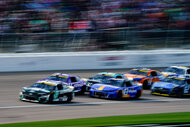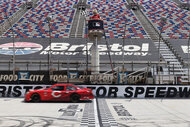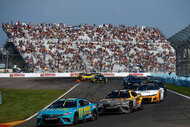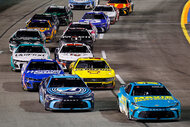NASCAR Makes 'Fiery' Changes To Driver Underwear
The league is toughening requirements regarding fire-resistant fashion elements.

This ain’t your average pair of Hanes or Fruit of the Loom tighty-whities.
In an effort to enhance safety protocols to protect its most vital asset – the drivers – NASCAR will now require racers to wear various fire-resistant clothing items, including a helmet skirt, socks and underwear.
The league had previously only recommended drivers wear such clothing.
The rule modifications stipulate that all approved gear must be specifically rated by either the SFI Foundation, Inc (SFI) or the Federation Internationale de l’Automobile (FIA), the two primary safety certification councils in stock car racing.
Both groups generate their certification ratings by analyzing a fabric’s Thermal Protective Performance (TPP), and to earn a TPP rating, a suit’s material, including zippers, is exposed to direct flame. The TPP results are translated into the number of seconds the fabric would be able to stave off second-degree burns in the wearer. The higher number of seconds the material holds up, the higher the TPP score is and the material’s subsequent certification rating.
RELATED: NASCAR’s Kyle Larson And Wife Katelyn Welcome New Baby Boy To The Family
Fire resistant and fire retardant are two vastly different certifications. Fire retardant applies to materials that have specifically treated with chemicals that are difficult to catch on fire or are self-extinguishing when contact is made with an open flame. Fire resistant, on the other hands, denotes fabrics created from materials that are intrinsically nonflammable, meaning their chemical structures possess built-in flame resistance. Highly engineered synthetic material such as Kevlar is made from what’s called aramid material, and aramid uses aromatic fiber. Aramid materials exhibit superb chemical, radiation and flame resistance, giving them critical applications in several major industries, like space exploration and construction.
While similar because they pass the minimum fire-resistances standards, aramid racing suits are often made with varying percentages of aramid material. DuPont makes the top-of-the-line Nomex racing suits, which can be quite pricey, and generally speaking, the higher the percentage of aramid material in the racing suit, the higher the cost. Suits that are constructed of 100 percent Aramid material have a distinct synthetic sheen to them and weigh less than those that are engineered from a composite weave. The cheapest option are the treated cotton suits, but why skimp when a couple hundred dollars could mean the difference between life or death?
FIA had previously pressured Formula 1 to adopt similar measures after several instances where driver checks found clothing violations with both underwear and jewelry.
After F1 bolstered their rules, the topic was thrust into the spotlight when Sebastian Vettel protested by wearing Puma underwear outside his race suit before the first free practice at the Miami Grand Prix.
“It was just a piss-take,” said Vettel at the time. “I don’t care, but it’s just funny that we keep talking about it.”
While some may joke about the modifications and declare them excessive, neither fans nor league brass from F1 or NASCAR want to see driver go through what Romain Grosjean endured when his crashed car at the 2020 Bahrain Grand Prix turned into a blazing inferno. F1 Race Director Niels Wittich cites the dramatic accident as a prime example as to why these types of regulations need to be in place and enforced. Wittich penned a letter, issuing a stark warning about the dangers of drivers wearing flammable material.
“The use of non-flameproof materials in contact with the driver’s skin, and in particular synthetic materials, can reduce heat transmission protection and thus increase the risk of burn injuries in the event of a fire,” Wittich wrote. “In the worst case, such materials may melt, which can hinder treatment in the event of a burn injury.”
Currently, NASCAR has not issued a protocol on how the league will navigate the somewhat precarious operation of making underwear checks, but if the checks are anything like those of the F1, from the star to the unknown, everyone will be subjected to the same scrutiny.
Can't get enough NASCAR action? Catch up on “Race For The Championship,” on Peacock.
















